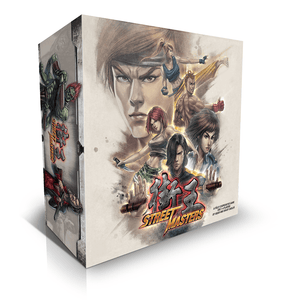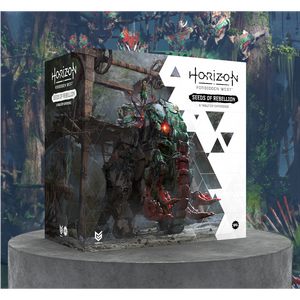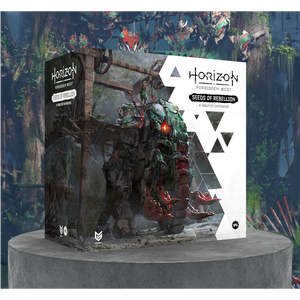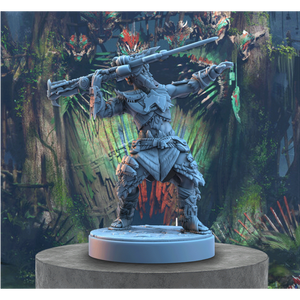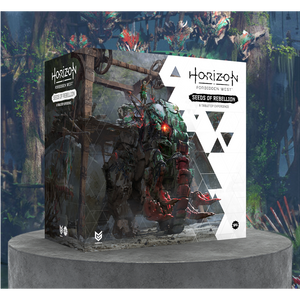Welcome, Tarnished, to the first in a series of Designer Diaries about ELDEN RING: The Board Game!
In these diaries, we’ll explore the game design, tabletop mechanics, and reveal unseen miniatures and components in the lead-up to the Kickstarter launch on November 22 (follow the campaign here). But first, a quick introduction to your author.
My name is Sherwin Matthews, and I’m the Lead Designer for Steamforged Games. In the past I’ve been fortunate enough to work on several triple-A video game adaptations, including Resident Evil 1, 2, and 3, Horizon Zero Dawn™, Gears of War™, Monster Hunter: World, and most recently the revised DARK SOULS™: The Board Game.
I’ve been incredibly happy to work not only alongside the rest of the Steamforged team on ELDEN RING: The Board Game, but also with FromSoftware and Bandai Namco. The result is a game we’re all extremely proud of, that takes the essence of what has made the video game the biggest release of the year and recreates that on the tabletop for a whole new experience.
Rather than drilling into any specifics just yet, for this first diary I wanted to instead give you a high-level overview of ELDEN RING: The Board Game, so we have a starting place from which to delve into more detail in future diaries.
So, with that in mind, let’s begin…
Foul Tarnished… In Search of the Elden Ring

The Samurai Tarnished is revealed! A martially potent fighter from the land of reeds.
Whenever I approach a new project, the first step is always to establish the key pillars of the source material are — its core DNA, if you will. This is even more important for licensed games; they have existing audiences and experiences that any adaptation must replicate. If you somehow don’t get that right, no matter how good your adaptation is, it won’t feel like the source material and fans will bounce off.
ELDEN RING is a truly massive game. Not just in the size of the world, but also in the depth of the lore and game mechanics. In short, there’s a lot of game to capture. Although you might think that would be intimidating, in truth it gave us a lot of fantastic material to work with. After all, ELDEN RING might be huge, but its core experiences are remarkably well defined.
For starters, we knew we wanted to drill into overland exploration in a big way.
Exploring the Tabletop Lands Between
So much of the video game is spent travelling from place to place, seeking out new locations, landmarks, enemies, and characters. The board game needed to deliver that same sense of wonderment at seeing what lies beyond the horizon, and feeling of excitement when you discover something new — be that rare resources, a dungeon, an enemy encampment, or any of the other myriad sites of interest in the game.
To achieve that on the tabletop, ELDEN RING: The Board Game uses a modular tile exploration system that allows you to journey across the Lands Between, interacting with the locations you discover, and placing new tiles as you step into the unknown. Those tiles, laid down as you explore, become both your game board and your map, allowing you to retread old ground or step into as-yet-uncharted territory to find something new.
Along the way, you’ll collect unique resources based on your location, trade with merchants, speak with NPC’s and, of course, have to contend with enemy patrols.
Which leads us nicely to another important element of the game: combat.
Board Game Combat
Combat in the ELDEN RING video game is not only a vital element of the game, but also incredibly deep and considered, more so than just about any other game I’ve played. Like in other FromSoftware titles, if you simply charge towards your foes in ELDEN RING, you’ll quickly get killed. Success in combat relies on player skill and decision making, and never on blind luck.
In ELDEN RING: The Board Game, you’ll each build a dedicated attack deck dependent upon your Tarnished’s equipment, crafted consumables, and any ashes of war attached to their weapons. The cards in this deck detail the attack range, power, and speed of your attacks, delivering a more granular and considered experience than simply rolling dice. This continues into your Tarnished’s damage deck, which will be customised as you play through your campaign by levelling up your Tarnished and increasing different stats.
And that, almost like I planned it, leads us to the last element I’m going to highlight for now.
Campaign Gameplay
I’ve already mentioned the sheer size of the ELDEN RING video game, and I’m sure if you’ve played it, you’ll attest to the many hours you’ve sunk into doing so. The pace at which the game unfolds across the massive playing area, and its obfuscated storytelling, are almost as iconic as the creatures that exist within the world.

The Troll is revealed!
"The lesser giants who fought for the Erdtree during the War against the Giants long ago. Though the giants have lost their minds, they stay inseparable from their swords that are in sad shape—such that the gold plating had flaked away."
With that in mind, there really was no other choice than to make ELDEN RING: The Board Game a campaign game, rather than one that could be completed in a single session. This unlocked the potential for character progression between sessions, which in turn unlocked levelling up, crafting, and smithing for equipment. In the end, anything else would have felt entirely out of keeping with the experience of playing the source material.
But that’s not all. Because the video game is so large, we faced an interesting design decision.
Translating ELDEN RING to the Tabletop
Like a movie that’s been adapted from a book, things that work well on screen don’t always work the same way in print, and vice versa. When we create any board game adaptation, rather than trying to shoehorn an entire video game world and all its mechanics into one box-sized, analogue format, our main goal is to recreate the core experience in a way that feels authentic and is enjoyable to play on the tabletop.
With that said, it’s always incredibly important to us that our tabletop adaptations feel faithful to the original game, and with ELDEN RING this was more true than ever.
Returning to the pillars I mentioned earlier, we wanted the board game to give you the same sense of discovery in a slowly unfolding world that you would get when playing the video game. We wanted you to discover familiar locations and interact with characters you recognised, and not worry they’d been skipped or missed out.
We didn’t want you to feel like you’d missed large chunks of the game purely because we were trying to fit everything onto the tabletop all at once and couldn’t possibly include every boss, enemy, weapon, and location. We were also extremely conscious of how attempting to do so would bloat the project massively into something quite confusing and unmanageable — both for backers, and from a logistics perspective.
Therefore, the first ELDEN RING: The Board Game release focuses primarily on Limgrave and the Weeping Peninsula, allowing you to delve into the region in a much deeper way than would otherwise have been possible.
Future releases will then follow that continue your Tarnished character's journey as we expand the tabletop Lands Between to include other areas, giving those deep and individually detailed regions the space and attention they deserve.
Emboldened By The Flame of Ambition
That’s all from me for now, but I’ll be back in the weeks to come, where I’ll elaborate on exploration, diceless combat, and more. For now, arise, and enter the Roundtable Hold, where all Tarnished gather, for there we shall hear fables more to come…


 Join us on Discord
Join us on Discord


